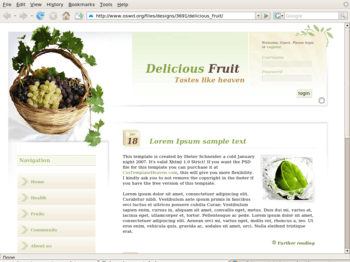Web Design/Design Principles for Web Design
< Web Design|
Web Design → Design Principles for Web Design
|
| |
Completion status: this resource is just getting off the ground. Please feel welcome to help! |
Module Aim
In this module, we will consider some of the principles that you should remember and adhere to whenever making you website. We'll consider color blending on your website, what fonts are much web-friendy, image support and even creating your website to suit the kind of people you're aiming at. This module will expand more on issues like webpage load speed and what code to use with what scripts at what time. Knowing which of the web design standards to use such as HTML or HTML5 will also be a point of focus. The following sections has got much to offer. Go ahead.
Apart from the principles you need to nail down when designing your site, you need to also understand certain facts about your visitors and how to organize your contents for best first impression.
Suggested Activities
Under this section, we'll be considering some activities of which you will work on to see how best the principles discuss really work.
Since you're familiar with creating of HTML pages, only instructions on the activities will be given and you will have to try them yourself. Taking on these activities will help you appreciate how important those principles are and how they are going to facilitate the overall operation of your webpages. Its much important your take to heart these principles.
Basic Principles Grouped
The basic principles to keep in mind when creating your website can be grouped under some four main headings. These kind of categorize the whole idea of those principles. These are:
- Colors
- Layout
- Navigation
- Fonts
Colors
Layout
Navigation
Fonts
Learning materials
Wikiversity lessons:
Resources
The following are external links that relate to Web Design Principles
Articles worth reading
- The principles of Design - Starting with the basics of Balance, Proportion and Dominance, this article uses simple examples and has useful links too.
- The elements of Design - Part 2 in the series, introduces the basic elements of design (point, line, form, texture, colour) and related areas.
- Designing for the Web - Part 3 in the same series.
- Principles and Elements of Design - Part 4 in the same series, brings everything together with examples.
- Choosing a colour scheme - Dave Shea's own tips for choosing a colour scheme for your website (includes some great links).
- Web Design Tutorial - An all-in-one guide for basic Web Designing tips. (includes links to other popular articles).
Online tutorials
- WebDesign from Scratch - This section on visual design for clarity has some excellent explanations.
- The Principles of Beautiful Web Design - Explains much you need to read about.
- Top 22 Web Design training - Links to the 22 top tutorials for web designing.
Online references
- The Web Style Guide - This section on Designing a User-Centered interface as well as the Visual Heirarchy section apply design principles directly to web design.
Recommended Books
Related Qualifications
HTML: What is HTML, Advanced HTML Tutorial, HTML Challenges, Lists and Tables, The Structure of HTML, Pen and Paper HTML activities
CSS: Learning Basic HTML and CSS, CSS challenges, Embedded CSS, Basic HTML and CSS Tutorial, Inline CSS, Develop cascading style sheets, CSS3 Animations
PHP: Simple functions in PHP, Dynamic websites, PHP challenges, Dynamic websites with PHP, Generating a receipt with PHP, Responding to HTML forms with PHP,
JavaScript: An Introduction to Programming with JavaScript, JavaScript Challenges, Getting to know JavaScript events, Getting to know the Document Object Model with JavaScript, JavaScript pen-n-paper activities, Web Programming Intro, Produce basic client side script for dynamic web pages
XML: XML challenges
Databases: Creating Database Tables
Projects: A small website project, A step-by-step web design project, Build a basic web page, Build a small website
Challenges: Web design, HTML, AJAX, CSS, JavaScript, PHP, XML, Information Architecture, Algorithms
Activities: Web design group learning activities, Pen and Paper HTML activities, A Web Design Quiz show, Ordering Tasks for a Web Project, Paired Bio Pages, Scoping a Small Project, Emerging Technologies Research Activities
Project management: An introduction to Project Management, Developing a Client Project
Design: Accessibility, Design Principles for Web Design, Design Suggestions
Testing: Testing Website performance, Website Performance Test Plan
Publishing: Getting Your Site On the Web
Certification and standards: Cert IV Website Qualifications in Australia, Australian Qualifications, Web design qualifications
Professional development: Contribute to personal skill development and learning, Useful Applications, Useful Books, Emerging Technologies, Using the Internet as a Learning Tool
Course meta-information: Web Design, About the web design learning project, New Structure, Sample Timetable

